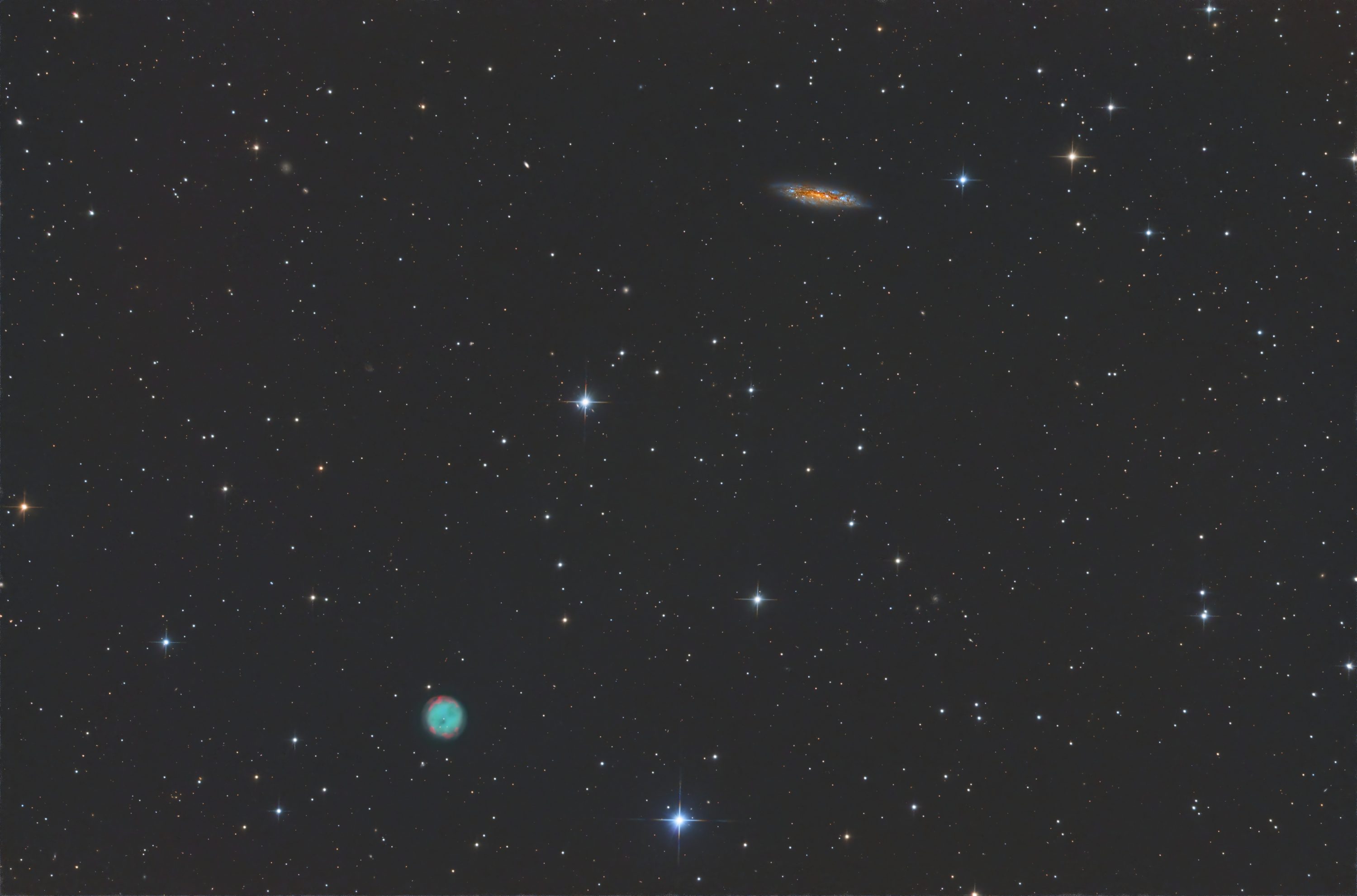No products in the cart.
M97 the Owl Nebula and M108 the Surfboard Galaxy
The night sky is full of wonders, and two fascinating celestial objects are M97, also known as the Owl Nebula, and M108, the Surfboard Galaxy. These deep-sky objects are a favorite among amateur astronomers and stargazers alike.
What is M97, the Owl Nebula?
M97 is a planetary nebula located in the constellation of Ursa Major, about 2,600 light-years away from Earth. It was first discovered by French astronomer Pierre Méchain in 1781 and later cataloged by Charles Messier. The nebula gets its name from its resemblance to an owl’s face, with two dark patches resembling the eyes and a bright circular center resembling the beak.
Physical Characteristics of M97
The Owl Nebula has a diameter of approximately 0.4 light-years and is expanding at a rate of about 14 kilometers per second. Its central star, which is responsible for ionizing the nebula, is a white dwarf with a surface temperature of about 120,000 K.
Observing M97
M97 is best observed in the spring and summer months in the northern hemisphere. It can be found in the constellation of Ursa Major, near the star Merak. With a telescope, you can see the bright circular center and the surrounding shell of gas and dust. The nebula has a magnitude of 9.9, making it visible in moderately sized telescopes.
What is M108, the Surfboard Galaxy?
M108 is a spiral galaxy located in the constellation of Ursa Major, about 45 million light-years away from Earth. It was discovered by French astronomer Pierre Méchain in 1781, and later cataloged by Charles Messier. The galaxy gets its name from its elongated shape, which resembles a surfboard.
Physical Characteristics of M108
M108 has a diameter of approximately 120,000 light-years, making it about the same size as our Milky Way galaxy. It has a bright central bulge and several spiral arms, containing young stars and star-forming regions. The galaxy is also home to several supernova remnants, indicating a history of intense star formation.
Observing M108
M108 is best observed in the spring and summer months in the northern hemisphere. It can be found in the constellation of Ursa Major, near the star Merak. With a telescope, you can see the galaxy’s elongated shape and its bright central bulge. The galaxy has a magnitude of 10.7, making it visible in moderately sized telescopes.
Tips for Observing M97 and M108
- Find a dark location away from light pollution for the best viewing experience.
- Use a telescope with at least a 6-inch aperture to see the details of these objects.
- Allow your eyes to adjust to the darkness for at least 20 minutes before observing.
- Use low magnification to locate the object, then increase magnification to see the details.
- Use averted vision to see fainter details.
Image technical:
- Starfield Optics 8″ Astrograph (native F4) http://bit.ly/3WOrKsf
- Starizona NEXUS .75 reducer/coma corrector for F3 https://bit.ly/3MCijaB
- QHY268M CMOS Camera (https://bit.ly/3Aj23FE), 26mp, 3.76um @ -10C
- QHY CFW3-L 7 position https://bit.ly/3IiYoxY
- Optolong filters (HaLRGB) https://bit.ly/3WQd5N7
- Skywatcher EQ6 mount https://bit.ly/3jEonpC / Skyshed Pier (Skyshedpod.com)
- Pegasus Astro Focus Cube https://bit.ly/2NDdEb2
- NINA 2.0 for acquisition https://nighttime-imaging.eu/
- Processed in PixInsight
- Seeing and transparency: average to good
- Total integration time: 7hr 40min (1min subs at high gain)
- Location: Kitchener, Ontario, Canada
Buying astro gear? Help support my efforts in bringing the astro community new content (videos, tutorials, tips, reviews) by using these affiliate links to purchase astro equipment. I’ll receive a small commission at no cost to you.
Ontario Telescope (Canada)
All-Star Telescope (Canada)
New to Pixinsight image processing? Get in touch! I provide one-on-one lessons via Zoom.
You can also buy me a coffee via…
https://paypal.me/visibledark or https://www.buymeacoffee.com/visibledark

My story began more than 40 years ago looking up at the Moon with a small telescope my Father had. Encouraged by my parents, who bought me my very own telescope, a 4.5″ reflector, I began to explore the night sky from my family home backyard. Today I do astrophotography from my home in Kitchener, Ontario and also with remote telescopes located in New Mexico and Australia. Some of my images have won awards and have been featured online and in magazines.



Leave a comment...